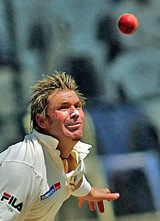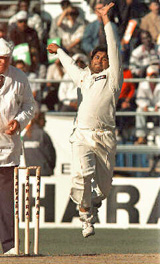ARTICLES
LEG-SPIN - TRICKS OF THE TRADE
- By S.P Bhatia
Leg-spinners are by and large attacking bowlers, whose primary aim is to take wickets and put the opposition under pressure. The quality leg-spinner ought to have a whole lot of variations up his sleeve, which if executed well, can befuddle the best of batsmen. Let's take a look at the key components of a leg-spinner's repertoire:
A. The top-spinner: The top-spinner is a delivery that maintains its direction after pitching and usually involves the use of the third finger in such a manner, that the seam rotates vertically and the ball reaches the batsman quicker than the leg-break. The grip for a top-spinner is the same as that for a leg-break, the only difference being that the ball is released just before the hand reaches the highest point of the swing, so that the ball travels towards the batsman in an upward and forward direction. The ideal top-spinner should pitch on a good length and on or just outside off-stump.
C. The flipper: The wrist-spun flipper is bowled with flatter trajectory, and skids off the pitch much quicker than expected and keeps low. The bowler imparts backspin to bowl a flipper.
A. The top-spinner: The top-spinner is a delivery that maintains its direction after pitching and usually involves the use of the third finger in such a manner, that the seam rotates vertically and the ball reaches the batsman quicker than the leg-break. The grip for a top-spinner is the same as that for a leg-break, the only difference being that the ball is released just before the hand reaches the highest point of the swing, so that the ball travels towards the batsman in an upward and forward direction. The ideal top-spinner should pitch on a good length and on or just outside off-stump.

The master leg-spinner lets
one rip - Shane Warne is
the proud possessor of a prodigious leg-break and
a lethal flipper.
B. The googly / wrong 'un: The wrong 'un or googly is a delivery that appears to be a wrist-spun leg-spinner, but in fact turns in the opposite direction; from off to leg. While the grip for the googly is the same as that for the leg-break, the run-up is shorter, but livelier in the final two or three strides. A leg-spinner of any standing will be able to 'disguise' the final few strides and thus prevent an observant batsman from sighting the difference in the run-up and thus prepare himself to face the googly. As in the case of a top-spinner, the ball should be released just before the hand reaches its highest point. However, at the time of release, the wrist should be rotated. The fingers should be first turned inwards, then outwards, downwards, upwards, forward and downwards again. The third finger pushes the ball and rotates the seam hard towards fine-leg. The thumb assists to spin the ball from the off to the leg-side. The googly is one of cricket's most deceptive weapons, so much so that even the men who bowl it well find it a difficult delivery to deal with when they are at the receiving end. The mind goes back to India's historic win over Australia at Kolkata in March 2001. Sachin Tendulkar got three key wickets in the second innings, including one off a priceless googly. The batsman was....you guessed it, Shane Warne! The googly is a delivery meant to confuse the batsman, and hence, it should be used sparingly as a 'shock' tactic.

Mushtaq Ahmed - He had a deadly googly, but tended
to bowl it too often, thus nullifying the 'shock' factor.
The requirements for the same are:
The grip is same as that of the leg-spinner, but the closed action is used.
Flipper involves a lot more use of the body to extract more pace and nip off the pitch.
The ball is bowled similarly as leg spinner but instead of the third finger pushing the ball, all the fingers are dragged down the back of the ball. Release the ball out of the front of the hand through the fingers.
The ball is pitched short of length.
The only one of his kind: Jack Iverson, who played Test cricket for Australia in 1950-51, was a unique leg-spinner. He had huge hands and therefore was able to hold the ball between the index and the ring finger with the middle finger being underneath the ball. He imparted spin to the ball by flicking the middle finger. This action enabled him to bowl more googlies than the regular leg-break and deceive the batsman.
The grip is same as that of the leg-spinner, but the closed action is used.
Flipper involves a lot more use of the body to extract more pace and nip off the pitch.
The ball is bowled similarly as leg spinner but instead of the third finger pushing the ball, all the fingers are dragged down the back of the ball. Release the ball out of the front of the hand through the fingers.
The ball is pitched short of length.
The only one of his kind: Jack Iverson, who played Test cricket for Australia in 1950-51, was a unique leg-spinner. He had huge hands and therefore was able to hold the ball between the index and the ring finger with the middle finger being underneath the ball. He imparted spin to the ball by flicking the middle finger. This action enabled him to bowl more googlies than the regular leg-break and deceive the batsman.